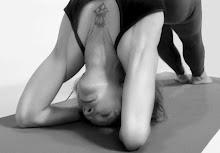Yoga and Research
To address the issue of Cardiorespiratory fitness, the study authors also studied a 1 hour power Yoga class; this found that modest benefits can be gained by attending a more vigorous class.
However, no Western study to date (that I know of) has studied traditional Yoga (practicing 6 days per week as recommended by the Gurus) or the Ashtanga method as taught by Pattabhi Jois. The practice of Ashtanga Yoga becomes quite vigorous and aerobic with the entire "routine" taking about 90 minutes to complete. Many of those who begin this method have found that they have lost bodyfat/weight (losing inches) while becoming stronger, and also notice that they are less winded during daily activities such as climbing stairs. Surely this shows an aerobic benefit is possible. Will the research community step up and study this phenomenon? The difference between "health club" yoga and traditional Yoga is like the difference between walking and running.
Perhaps a new study can be designed that contrasts the differences between the sedentary group, the typical health club 1 hour format, and the traditional method of 90 minute to two hour classes with practitioners practicing on their own so that everyone in that group gets six days per week under their belts. And yes, each person can work at their own pace (the essence of Mysore style is that the asana is modified for the student, not making the student practice asana that is inappropriate for their level of ability). I believe it can be done.
Om shanti!



